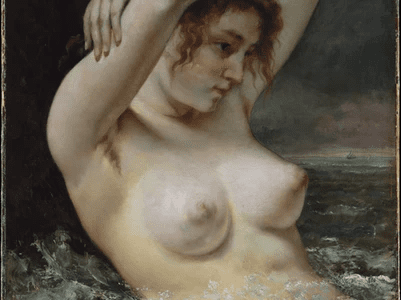
Gustave Courbet, ‘The Woman in the Waves’
Realism school Painted in 1868, oil on canvas. Dimensions:65.4 cm x 54 cm

Alexandre Cabanel,
‘The Birth of Venus’ – Painted in 1863
Dimensions: 106 cm x 182.6 cm
“Courbet courted controversy painting prostitutes by the Seine, images of lesbianism and probably the most controversial of all, ‘The Origin of the World’.”, which still evokes powerful emotions today, possibly even more.
Realism emerged in France around the 1840s rejecting the previous art movement of Romanticism and lofty historical paintings with its emphasis on exotic exaggerated emotions and drama. Courbet was considered the leader of this radical and reactionary art movement. The realists included Jean-François Millet, and Jean Baptiste Camille.
The terms, Realist and Realism are often misunderstood. ‘Realism’ is not about art looking like a photograph, it is not about highly finished renderings of skin tones etc but a ‘social realism’, portraying the subject without idealising, presenting everyday life and situations without judgment depicting the realities of life for ordinary people unidealised. The realists accepted the unsavoury and sordid side of life. It was the very opposite of the Academy’s dictates of perfection.
Observations:-
A portrait format painting close-cropped to a single young woman in the sea. Her top part exposed out of the water and the lower parts submerged in the splashing foaming dark green sea. Her upper body creates a 90-degree perpendicular. Her arms are crossed and holding each other above her head placing her face in shadow. Her ginger/red hair is wet and straggling, she sports dark armpit hair and her large breasts are highlighted by whiter pinker flesh tones. The dark sea stretches deep into the horizon which is set halfway through the middle of the painting and just on the upper line of the top of the breasts. Above the horizon is a darker sky. On the horizon line, we see the crest of a wave with two sailing ships and a suggestion of a spit of land or a slither of sky.
The Woman in the Waves, was painted in 1868, five years before ‘Impression-Sunrise’ in 1873 painted by Claude Monet which heralded the beginnings of the much-loved Impressionism movement leading to the beginning of the Modern Art period.
This smaller than usual size painting (The Academy liked large-scale paintings) subverts the usual Academic trope of the goddess Venus. Sombre earthy tones of colour, a rougher painterly technique and warts and all unidealised naturalism were employed as a rejection of the idealised beauty of the Academy artists.
Venus is not ethereally born aloft on the crest of a gentle wave but rather drowning. No expansive seascape format but a close-cropped portrait which focuses squarely on her isolated precarious situation. The sea is rough and turbulent with frothy white crests and a foreboding deep green. She is alone, with no accompanying winged cherubs announcing her arrival with conch shells. Her glorious mass of wavy hair is reduced to a sodden straggle. Her arms covering her head feels like protection rather than an awakening. Her skin is not flawless like fine porcelain, and her body and breasts are not a vision of perfect beauty. This goddess has flaws. Her skin is blotchy, and the green in the flesh tones makes her look sickly. Her breasts have real worldliness with a sense of reality, not fantasy. There is an intended awkwardness to her crouching body which creates a 90-degree perpendicular adding a dynamic of half the body in one direction and the other half heading in another. The general darkness of her surroundings and background means she is firmly the attention of the painting with no superfluous frothy detail to distract. The background is dark and foreboding with a hint of detail on the horizon line here we see a glimmer of light, the crest of a wave with two tiny sailing ships and a suggestion of a spit of land or a slither of light and sky that is on the centreline of the canvas and creates a connection directly inline with the breasts.
This painting is an excellent example of the meaning of Realism as an art movement.
Written by Paul Woods
LOVE ART, LOVE LIFE
Recommend0 recommendationsPublished in Art History, Art Movements, Artists, Artworks, Resources


Responses